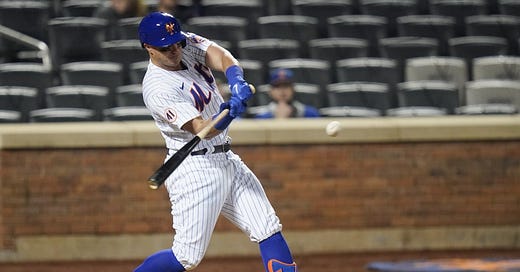James McCann's $40 Million Swing
McCann had a bad 2021 season — but a closer look at the numbers suggest that there's room for him to rediscover his swing.
Happy New Year! To kick off 2022, we look at a player who no one seems to talk about, but who might play a key role on the 2022 Mets: James McCann, who’s either a stud catcher or a guy who turned a lucky stretch into a big contract. We’ll see — at least, you will if you read on. Enjoy!
What’s the deal with James McCann? That’s not the start of a Seinfeld bit, even though it sounds like it. “Hey, what’s the deal with James McCann? What’s McCann? What is that, an optimistic Irish family? Yes, I McCann?”
Seriously though, what is the deal with James McCann? I ask because a lot of Mets fans seem to be forgetting that it’s a question at all. McCann is only a year removed from signing a four-year contract worth $40 million. That came after he batted .276/.334/.474 over 2019 and 2020. Obviously, he had a bad year in 2021 (.643 OPS), but anything can happen in one year, and everyone seems to be forgetting that James McCann has at least a chance to be a legitimate hitter at the back end of the Mets’ lineup.
The real question about McCann, of course, is where his true talent level is. He’s almost certainly never going to put up an .896 OPS — as he did in the shortened 2020 season — again. But I can’t help but think that he’s also better than he was in 2021. Among pessimistic Mets fans, it’s fashionable to argue that McCann’s 2019/2020 stretch was an aberration, and his career prior to that (.240/.288/.366) is where he really is as a hitter. But that’s a logical fallacy. Just as you can’t say “James McCann was good the last two seasons, therefore he’s a good hitter,” you also can’t say “James McCann has been bad besides in 2019 and 2020, therefore he’s not a good hitter.” Yes, McCann has had his share of bad offensive seasons, but 2019 and 2020 also happened. McCann has demonstrated that at least sometimes, he’s an excellent hitter. The question is whether he can do it again.
As these things often do, it comes down to BABIP. McCann posted a .359 BABIP in 2019 and a .339 BABIP in 2020. In 2021, on the other hand, it fell to .304, just as in 2018, before McCann’s bat took off, it was .282. That tracks with swing data: in 2019, McCann’s average exit velocity was in the 67th percentile, according to Baseball Savant. His barrel rate was in the 60th; his hard-hit rate was in the 78th. In 2020, McCann’s average exit velocity was 90.5 miles per hour, even higher than his 2019 number. His barrel rate rose to 8.7%, again higher than his 2019 number. His hard-hit rate likewise rose to 47.8%. In 2019 and 2020, McCann wasn’t just finding flukes and getting lucky; he was hitting the ball really hard.
In 2021, by contrast, McCann’s average exit velocity fell to the 19th percentile. His hard-hit rate was in the 47th, and his barrel rate fell to the 28th. So it’s not just that McCann got lucky in 2019 and 2020, and balls off his bat stopped finding holes in 2021. Back in 2019 and 2020, when his offensive numbers took off, he was actually hitting the ball a lot harder, and in 2021, when his numbers sank, the ball slowed down off his bat.
So what changed from 2020 to 2021? For one, McCann changed where he hit the ball. Historically, he’s been an opposite-field hitter; the rate at which he went oppo hovered around 30% for most of his career, and his oppo rates in 2019 and 2020, the two best seasons he’s had, were the highest numbers of his career. In 2021, meanwhile, his opposite field rate fell to 25.5%. As he detailed to Tim Britton of The Athletic, trying too hard to hit the ball the other way may actually have harmed his swing — but whatever the problem was, it’s clear that there was a problem. It wasn’t just good luck then bad luck; something in McCann’s swing changed.
McCann’s swing changed direction horizontally; it also changed direction vertically. His ground ball rate from 2016 to 2020 was between 37% and 45%. In 2021, it rose to 51.5%. More grounders, of course, means McCann hit fewer line drives and fly balls, which are more likely to turn into hits. His line drive rate, which ranged from 22% to 28% between 2017 and 2020, fell to 19.8% in 2021. His fly ball rate, between 32% and 40% over that same period, fell to 28.6%. McCann’s average launch angle has been between 10 and 17 degrees since 2016, above 15 degrees in all but one of those years; in 2021, it fell to 9.3 degrees.
The key takeaway here is that McCann isn’t just a bad hitter who got lucky for two years. It really does seem like something changed in his swing between 2020 and 2021. As long as the lockout continues, the Mets have all the time in the world to find a new hitting coach. If they can find someone who can figure out what changed in McCann’s swing, and how to change it back, McCann will remind Mets fans why he’s earning $40 million — and the Mets will take another step away from their competition in the National League.




